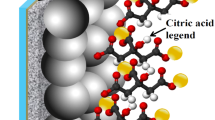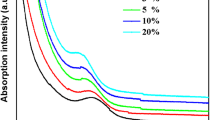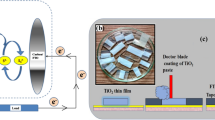Abstract
In this work, the influences of cationic precursors on the quality of photoelectrode, consequently on the performance of the quantum dot-sensitized solar cells (QDSCs) have been studied. CdS QDSCs have been prepared using successive ionic layer absorption and reaction (SILAR) method. Three cadmium precursors including nitrate (Cd(NO3)2), chloride (CdCl2), and acetate (Cd(Ac)2) were employed for the synthesis and absorption of CdS nanoparticles on nanostructure TiO2 film. The loading amount and nanoparticle size of the CdS on mesoporous TiO2 film showed a significant difference while using various cadmium precursors in the same SILAR cycles. Both the light-harvesting ability and the obtained incident photon-to-current conversion efficiency values show the trend of deposition rate caused by cadmium precursors. Further, it was proposed that an effective cationic precursor could provide a good connection between QD sensitizer and TiO2 interface by electrochemical impedance spectroscopy analysis. Under AM 1.5 G full one sun illumination, the final power conversion efficiency of CdS QDSC based on Cd(Ac)2 was 2.10 %, and PCE values of 1.57 and 1.20 % were obtained for solar cells sensitized by CdS QDs prepared by CdCl2 and Cd(NO3)2, respectively. The cationic precursor effect was further applied in PbS/CdS co-sensitized solar cells. The PbS/CdS QDSCs based on acetate cationic precursors provide a photocurrent of 19.24 mA/cm2 and PCE of 3.23 % in comparison with 11.26 mA and 2.13 % obtained with nitrate acetate salts. Noticeably, the CdS and PbS/CdS QDSCs based on various cationic precursors prepared by SILAR exhibited good photocurrent stability under several light on–off cycles.










Similar content being viewed by others
References
Ardalan P, Brennan TP, Lee HB, Bakke JR, Ding IK, McGehee MD, Ben SF (2011) Effects of self-assembled monolayers on solid-state CdS quantum dot sensitized solar cells. ACS Nano 5:1495–1504. doi:10.1021/nn103371v
Baker DR, Kamat PV (2009) Photosensitization of TiO2 nanostructures with CdS quantum dots: particulate versus tubular support architectures. Adv Funct Mater 19:805–811. doi:10.1002/adfm.200801173
Braga A, Giménez S, Concina I, Vomiero A, Mora-Seró I (2011) Panchromatic sensitized solar cells based on metal sulfide quantum dots grown directly on nanostructured TiO2 electrodes. J Phys Chem Lett 2:454–460. doi:10.1021/jz2000112
Chang CH, Lee YL (2007) Chemical bath deposition of CdS quantum dots onto mesoscopic TiO2 films for application in quantum-dot-sensitized solar cells. Appl Phys Lett 91:053503. doi:10.1063/1.2768311
Chen G, Seo J, Yang C, Prasad PN (2013) Nanochemistry and nanomaterials for photovoltaics. Chem Soc Rev 42:8304–8338. doi:10.1039/C3CS60054H
Chen Z, Peng W, Zhang K, Zhang J, Yang X, Numata Y, Han L (2014) Band alignment by ternary crystalline potential-turning interlayer for efficient electron injection in quantum dot-sensitized solar cells. J Mater Chem A 2:7004–7014. doi:10.1039/C3TA15435A
Gao R, Wang L, Geng Y, Ma B, Zhu Y, Dong H, Qiu Y (2011) Effects of an intercalation nanocomposite at the photoanode/electrolyte interface in quasi-solid dye-sensitized solar cells. J Phys Chem C 115:17986–17992. doi:10.1021/jp204466h
Giménez S, Mora-Seró I, Macor L, Guijarro N, Lana-Villarreal T, Gómez R, Diguna LJ, Shen Q, Toyoda T, Bisquert J (2009) Improving the performance of colloidal quantum-dot-sensitized solar cells. Nanotechnology 20:295204–295209. doi:10.1088/0957-4484/20/29/295204
González-Pedro V, Xu X, Mora-seró I, Bisquert J (2010) Modeling high-efficiency quantum dot sensitized solar cells. ACS Nano 4:5783–5790. doi:10.1021/nn101534y
González-Pedro V, Sima C, Marzari G, Boix PP, Giménez S, Shen Q, Dittrich T, Mora-Seró I (2013) High performance PbS quantum dot sensitized solar cells exceeding 4% efficiency: the role of metal precursors in the electron injection and charge separation. Phys Chem Chem Phys 15:13835–13843. doi:10.1039/C3CP51651b
Gorer S, Hodes G (1994) Quantum size effects in the study of chemical solution deposition mechanisms of semiconductor films. J Phys Chem 98:5338–5346. doi:10.1021/j100071a026
Graetzel M, Janssen RAJ, Mitzi DB, Sargent EH (2012) Materials interface engineering for solution-processed photovoltaics. Nature 488:304–312. doi:10.1038/nature11476
Guijarro N, Campiña JM, Shen Q, Toyoda T, Lana-Villarreal TL, Gómez R (2011) Uncovering the role of ZnS treatment in the performance of quantum dot sensitized solar cells. Phys Chem Chem Phys 13:12024–12032. doi:10.1039/C1CP20290A
Hardin BE, Snait HJ, McGehee MD (2012) The renaissance of dye-sensitized solar cells. Nat Photon 6:162–169. doi:10.1038/nphoton.2012.22
Hodes G, Manassen J, Cahen D (1980) Electrocatalytic electrodes for the polysulfide redox system. J Electrochem Soc 127:544–549. doi:10.1149/1.2129709
Hossain MA, Jennings JR, Koh ZY, Wang Q (2011) Carrier generation and collection in CdS/CdSe-sensitized SnO2 solar cells exhibiting unprecedented photocurrent densities. ACS Nano 5:3172–3181. doi:10.1021/nn200315b
Ito S, Murakami TN, Comte P, Liska P, Gratzel C, Nazeeruddin MK, Gratzel M (2008) Fabrication of thin film dye sensitized solar cells with solar to electric power conversion efficiency over 10%. Thin Solid Films 516:4613–4619. doi:10.1016/j.tsf.2007.05.090
Kamat PV (2008) Quantum dot solar cells. Semiconductor nanocrystals as light harvesters. J Phys Chem C 112:18737–18753. doi:10.1021/jp806791s
Kamat PV (2013) Quantum dot solar cells. The next big thing in photovoltaics. J Phys Chem Lett 4:908–918. doi:10.1021/jz400052e
Kosmulski M (2009) pH-dependent surface charging and points of zero charge. IV. Update and new approach. J Colloid Interface Sci 337:439–448. doi:10.1016/j.jcis.2009.04.072
Lai CH, Chou PT (2011) All chemically deposited, annealing and mesoporous metal oxide free CdSe solar cells. Chem Commun 47:3448–3450. doi:10.1039/C0CC04404K
Lai LH, Protesescu L, Kovalenko MV, Loi MA (2014) Sensitized solar cells with colloidal PbS–CdS core–shell quantum dots. Phys Chem Chem Phys 16:736–742. doi:10.1039/c3cp54145b
Lee YL, Huang BM, Chien HT (2008) Highly efficient CdSe-sensitized TiO2 photoelectrode for quantum-dot-sensitized solar cell applications. Chem Mater 20:6903–6905. doi:10.1021/cm802254u
Lee YH, Im SH, Chang JA, Lee JH, Seok SI (2012) CdSe-sensitized inorganic–organic heterojunction solar cells: the effect of molecular dipole interface modification and surface passivation. Org Electron 13:975–979. doi:10.1016/j.orgel.2012.02.011
Lee JW, Son DY, Ahn TK, Shin HW, Kim IY, Wang SJ, Ko MJ, Sul S, Han H, Park HG (2013) Quantum-dot-sensitized solar cell with unprecedentedly high photocurrent. Sci Rep 3:1050. doi:10.1038/srep01050
Leventis HC, O’Mahony F, Akhtar J, Afzaal M, O’Brien P, Haque SA (2010) Transient optical studies of interfacial charge transfer at nanostructured metal oxide/PbS quantum dot/organic hole conductor heterojunctions. J Am Chem Soc 132:2743–2750. doi:10.1021/ja909172p
Liu JC, Huang CP (1992) Electrokinetic characteristics of some metal sulfide–water interfaces. Langmuir 8:1851–1856. doi:10.1021/la00043a027
Liu C, Li Y, Wei L, Wu C, Chen Y, Mei L, Jiao J (2014) CdS quantum dot-sensitized solar cells based on nano-branched TiO2 arrays. Nanoscale Res Lett 9:107–114. doi:10.1186/1556-276X-9-107
Meng K, Surolia PK, Thampi KR (2014) BaTiO3 photoelectrodes for CdS quantum dots sensitized solar cells. J Mater Chem A 2:10231–10238. doi:10.1039/C4TA00877D
O’Regan B, Gratzel M (1991) A low-cost, high-efficiency solar cell based on dye-sensitized colloidal TiO2 films. Nature 353:737–740. doi:10.1038/353737a0
Pan Z, Zhang H, Cheng K, Hou Y, Hua J, Zhong X (2012) Highly efficient inverted Type-I CdS/CdSe core/shell structure QD-sensitized solar cells. ACS Nano 6:3982–3991. doi:10.1021/nn300278z
Pan Z, Zhao K, Wang J, Zhang H, Feng Y, Zhong X (2013) Near infrared absorption of CdSe x Te1−x alloyed quantum dot sensitized solar cells with more than 6% efficiency and high stability. ACS Nano 7:5215–5222. doi:10.1021/nn400947e
Rabinovich E, Hodes G (2013) Effective bandgap lowering of CdS deposited by successive ionic layer adsorption and reaction. J Phys Chem C 117:1611–1620. doi:10.1021/jp3105453
Sambur JB, Novet T, Pakinson BA (2010) Multiple exciton collection in a sensitized photovoltaic system. Science 330:63–66. doi:10.1126/science.1191462
Santra PK, Kamat PV (2012) Mn-doped quantum dot sensitized solar cells: a strategy to boost efficiency over 5%. J Am Chem Soc 134:2508–2511. doi:10.1021/ja211224s
Sarma DD, Nag A, Santra PK, Kumar A, Sapra S, Mahadevan P (2010) Origin of the enhanced photoluminescence from semiconductor CdSeS nanocrystals. J Phys Chem Lett 1:2149–2153. doi:10.1021/jz100698m
Sun WT, Yu Y, Pan HY, Gao XF, Chen Q, Peng LM (2008) CdS quantum dots sensitized TiO2 nanotube-array photoelectrodes. J Am Chem Soc 130:1124–1125. doi:10.1021/ja0777741
Suttiponparnit K, Jiang JK, Sahu M, Suvachittanont S, Charinpanitkul T, Biswas P (2011) Role of surface area, primary particle size, and crystal phase on titanium dioxide nanoparticle dispersion properties. Nanoscale Res Lett 6:27. doi:10.1007/s11671-010-9772-1
Tada H, Fujishima M, Kobayashi H (2011) Photodeposition of metal sulfide quantum dots on titanium(IV) dioxide and the applications to solar energy conversion. Chem Soc Rev 40:4232–4233. doi:10.1039/C0CS00211A
Tian J, Cao G (2013) Semiconductor quantum dot-sensitized solar cells. Nano Rev 4:22578–22585. doi:10.3402/nano.v4i0.22578
Tian J, Gao R, Zhang Q, Zhang S, Li Y, Lan J, Qu X, Cao G (2012) Enhanced performance of CdS/CdSe quantum dot cosensitized solar cells via homogeneous distribution of quantum dots in TiO2 film. J Phy Chem C 116:18655–18662. doi:10.1021/jp3058838
Tian J, Lv L, Fei C, Liu X, Cao G (2014) A highly efficient (>6%) Cd1−x Mn x Se quantum dot sensitized solar cell. J Mater Chem A 2:19653–19659. doi:10.1039/c4ta04534c
Tubtimtae A, Wu KL, Tung HY, Lee MW, Wang GJ (2010) Ag2S quantum dot-sensitized solar cells. Electrochem Commun 12:1158–1160. doi:10.1016/j.elecom.2010.06.006
Vogel R, Hoyer P, Weller H (1994) Quantum-sized PbS, CdS, Ag2S, Sb2S3, and Bi2S3 particles as sensitizers for various nanoporous wide-bandgap semiconductors. J Phys Chem 98:3183–3188. doi:10.1021/j100063a022
Wang H, Luan C, Xu X, Kershaw SV, Rogach AL (2012) In situ versus ex situ assembly of aqueous-based thioacid capped CdSe nanocrystals within mesoporous TiO2 films for quantum dot sensitized solar cells. J Phy Chem C 116:484–489. doi:10.1021/jp209987q
Yang Z, Chen CY, Roy P, Chang HT (2011) Quantum dot-sensitized solar cells incorporating nanomaterials. Chem Commun 47:9561–9571. doi:10.1039/C1CC11317H
Yang J, Kim JY, Yu JH, Ahn TY, Lee H, Choi TS, Kim YW, Joo J, Ko MJ, Hyeon T (2013) Copper–indium–selenide quantum dot-sensitized solar cells. Phys Chem Chem Phys 15:20517–20525. doi:10.1039/c3cp54270j
Yella A, Lee HW, Tsao HN, Yi C, Chandiran AK, Nazeeruddin MK, Diau EWG, Yeh CY, Zakeeruddin SM, Gratzel M (2011) Porphyrin-sensitized solar cells with cobalt (II/III)-based redox electrolyte exceed 12 percent efficiency. Science 334:629–634. doi:10.1126/science.1209688
Yu WW, Qu L, Guo W, Peng X (2004) Experimental determination of the extinction coefficient of CdTe, CdSe and CdS nanocrystals. Chem Mater 16:560. doi:10.1021/cm033007z
Zhou R, Zhang Q, Tian J, Myers D, Yin M, Cao G (2013) Influence of cationic precursors on CdS quantum-dot-sensitized solar cell prepared by successive ionic layer adsorption and reaction. J Phys Chem C 117:26948–26956. doi:10.1021/jp410615b
Zhu G, Pan L, Xu T, Sun Z (2011) One-step synthesis of CdS sensitized TiO2 photoanodes for quantum dot-sensitized solar cells by microwave assisted chemical bath deposition method. ACS Appl Mater Interfaces 3:1472–1478. doi:10.1021/am200520q
Acknowledgments
The authors thank Department of Material Physics and Chemistry of Tianjin University for IPCE measurements.
Compliance with ethical standards
The authors declare no conflicts of interest in the submission of this manuscript. All authors of this research paper have directly participated in this study. All authors have read and approved the final version submitted.
Conflict of interest
The authors declare that they have no conflict of interest.
Author information
Authors and Affiliations
Corresponding author
Electronic supplementary material
Below is the link to the electronic supplementary material.
Rights and permissions
About this article
Cite this article
Liu, Y., Li, Z., Yu, L. et al. Effect of the nature of cationic precursors for SILAR deposition on the performance of CdS and PbS/CdS quantum dot-sensitized solar cells. J Nanopart Res 17, 132 (2015). https://doi.org/10.1007/s11051-015-2940-6
Received:
Accepted:
Published:
DOI: https://doi.org/10.1007/s11051-015-2940-6




